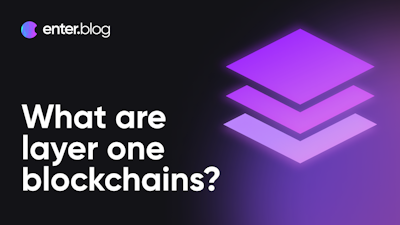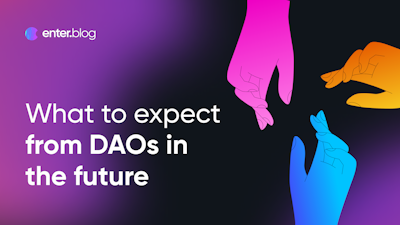
DeFi 101 - Part 2: Participating In DeFi The enter Way
DeFi is a fast-growing sub-sector in the blockchain industry. In the previous article, we discussed lending and liquidity provision. In this installment, we discuss other ways of participating in DeFi, and how enter offers amazing rewards for participation within its DeFi ecosystem.

Staking
Staking rewards you for participating in the consensus mechanism of a blockchain using staked tokens such as Avalanche (AVAX), Binance Coin (BNB), or Ethereum (ETH), effectively becoming a network validator. This is known as a proof-of-stake mechanism, and it is used to secure transactions and the network by blockchains such as BNB Chain, Avalanche, and Ethereum. Take note of how we use "ticker" symbols to refer to tokens and platform names to refer to them as a protocol. As the number of staked and thus "locked" tokens has increased, new concepts such as "liquid staking" have emerged, essentially creating a derivative of the staked token, which then becomes "liquid" and can be re-deployed while earning staking rewards.
Passive Staking
Unlike the actual staking where investors lock their crypto assets in order to reap pre-determined rewards after a period of time, passive staking is an innovative reward system that seeks to reward HODLers of a certain token. In essence, passive staking allocates a certain percentage of the total supply of a token to be distributed to HODLers of that token under certain conditions.
On the enter ecosystem, all transactions involving NFTART have a 10% transaction tax levied on them. Of this 10%, 50% (5% of the original value) is burned and 50% is distributed to HODLers of the NFTART token based on the percentage of the total ‘available’ supply that they HODL. For example, if 1 billion NFTART is used to purchase a music NFT on enter.audio, 10% of this value (100 million NFTART) is levied on the transaction. Of this 100 million, 50 million NFTART is burned and 50 million distributed to HODLers. Suppose a user holds 1% of the total NFTART supply, such holder gets 1% of the 50 million NFTART tokens that are distributed, i.e. 0.5 million NFTART tokens.
Yield Farming
Assume you lent money to a liquidity pool, such as SushiSwap, and began receiving your first SUSHI rewards. You don't want them to be idle. You could put them to work again through one of several opportunities and reap additional benefits. In a nutshell, yield farming is the activity of constantly putting your tokens to work — money never sleeps — in order to chase higher and compounding yields across protocols, pools, and others.
All of these activities provide an annual percentage yield (APY) or fee share split that varies depending on the platform used, such as Curve or Compound, services such as staking or liquidity provision, and underlying tokens such as BTC or USDC. These gains can take the form of deposited tokens (referred to as "Supply APY") or the platform's native token (referred to as "Rewards APY"). For example, the SushiSwap protocol will give you SUSHI tokens, while the Aave protocol will give you AAVE tokens. Some of these platforms distribute governance tokens, which give owners the right to vote on the platform's direction, such as the option of becoming an activist investor.
Yield farming is a greatly lucrative investment model within the enter ecosystem. Last year, NFTART was stealth launched, a passive reflection token that can be paired with BNB and farmed on farm.enter.art/#/farms using PancakeSwap liquidity pools. For investors, there is a two-fold reward stream. On one hand, users gain the statutory rewards that accrue when they receive a share on all transactions in the Liquidity Pool; in the same vein, users receive a reward from the protocol (in $NFTART) on transactions. On the other hand, the passive rewards explained in the passive staking section above also accrue on the NFTART-BNB liquidity pool. Besides being a passive reflection token, NFTART is used as the primary currency on enter's platforms.
Yield Farming and Impermanent Loss
With yield farming, it is important to keep in mind the concept of impermanent loss. When you lend money to a liquidity pool and the value of the assets you deposited changes from when you deposited them, this is known as an impermanent loss. The more significant the change, the greater the extent of temporary loss. In this instance, the loss represents a reduction in dollar value from the time of deposit to the time of withdrawal.
Let us take an example of Jake, someone who has lent funds to the ETH-DAI pool. Jake adds one ETH and one hundred DAI to a liquidity pool. The token pair that is deposited must have an equal value in the specific automated market maker (AMM). This indicates that the cost of ETH at the time of deposit is 100 DAI. Jake’s deposit was valued at USD 200 at the time of deposit.
Additionally, let us assume that there are 10 ETH and 1,000 DAI in the pool, which were sponsored by additional LPs like Jake’s. Therefore, Jake owns a 10% portion of the pool.
Consider an increase in the price of ETH to 400 DAI. Arbitrage traders will deposit DAI to the pool during this time and take away ETH from it until the ratio accurately represents the current price. Keep in mind that AMMs don’t have order books. The ratio between the assets in the pool is what determines the price of the assets in the pool. The pool's liquidity (10000) remains constant, while the ratio of its assets varies.
The proportion of ETH to DAI in the pool has changed if ETH is currently 400 DAI. Due to the work of arbitrage traders, the pool presently has 5 ETH and 2,000 DAI.
Jake decides to make a withdrawal. He is entitled to a 10% part in the pool, as we know from before. Thus, he is able to withdraw 400 USD, which is 200 DAI and 0.5 ETH combined. Since making his 200 USD deposit of tokens, he must have made some earnings. What if he had just held on to his one ETH and one hundred DAI? These assets' total current market worth would be $500 USD.
It is clear that Jake would have made more money HODLing ($500) than by making a deposit into the liquidity pool ($400). This is what we mean by impermanent loss. Given that the initial contribution was only a tiny sum, Jake’s loss in this instance wasn't very significant. However, keep in mind that impermanent loss can result in substantial losses (including a significant portion of the initial deposit).
For the aforementioned NFTART-BNB pair, if impermanent loss occurs in an NFTART-BNB LP and BNB is the depreciating asset, then NFTART is converted to BNB off-chain. Thus, this conversion is exempt from the transactional tax explained under passive staking and users "save" 10% on the NFTART converted to BNB. This means that the attendant risk with impermanent loss is defrayed on the user’s behalf.
The Landmines to Watch Out For
This could be an entire article in itself, so we’ll stick to some key highlights. First, use the house analogy to have a conscious awareness for your risk assessment across the layers and interdependency. With a focus on the protocols, or your counterparty risk, there are some specific levels you will want to review and ask critical questions about:
Team
Is the team known or an anonymous group? What is their technical and practical background? Are there any large/well-known backers of the crypto community involved?
Technicals
Have there been any hacks, are there third-party smart contract audits available and do they have security bounty prizes posted?
Tokenomics
Are governance tokens distributed? What is the current total value locked, and how are asset and active user growth numbers? Is the project managed by a community-supported decentralized autonomous organization (DAO)?
Insurance
Is there a treasury that will make investors "whole" again if there is a hack? Is there any insurance in place?
Pools
What are the APYs, and are they ridiculously high? — Is the APY stable, how much trading liquidity is in the pool, is there a risk of temporary loss, lockup periods, or transaction fees?
When you actively "use" your tokens to generate income, you are generally "hot" on these protocols/exchanges and thus more susceptible to hacks or counterparty risk. There are institutional providers, such as Copper, that provide secure custody not only for buy-and-HODL investors, but also for token staking at a cost. These security and custody issues are a key distinction between investing in DeFi by purchasing tokens that can then be tucked away in cold storage and operating a strategy that is constantly and actively generating income.
Summary
To summarize, we have been witnessing and will continue to witness the creation of a new trillion-dollar industry right in front of our eyes. However, one last word of caution: Keep an eye out for too-good-to be-true deals/APYs, as there is usually a catch, for fees that can suddenly balloon, diminishing returns on an active strategy and making smaller investments unattractive, and be cautious with the general safekeeping of your assets, as principal loss is possible.
If you're new to the game, start with some practice money and work your way up, testing and learning along the way. If you want to participate but don't want to deal with the hassle, you can also invest in professional managers who will design, implement, and monitor these strategies in an institutional setting. However, in your due diligence process of selecting a manager, you should use the same nuanced assessment approach that you used earlier.
This article is written by Chidera Anushiem as a part of enter.blog's bounty program. Do you have an interesting topic, series or subject you think would be fitting for enter.blog?
You can now submit your articles to enter.blog and get paid for your contributions!
Read more and submit your article here.
Crypto & Learning
Hungry for knowledge? Here you can get acquainted with blockchain, wallet security, DeFi and much more.

PUBLISHED 13TH MAY 2022
What Are Layer One Blockchains?
Layer one blockchains are like the foundation of a building. They are the base on which layer two blockchains are built. In this guest article, we’re getting to the core of what layer one blockchains are, and how scaling them is essential for NFTs.





